HOW TO SEND YOUR ARTWORK
It is very important to hand over your work without any damage during transport. Before you start shipping, you must have two goals - security of the package and well looking package.
Your delivery will be beautiful and secure if you have the right tools and materials. What will you need? These are mainly carton, strong packing tape, scissors, Knife (Box Cutter), wrapping paper, stretch plastic film, bubble wrap, ready cardboard box and stickers "fragile."
PACKING INSTRUCTIONS:
Measure the painting to determine the size of the outer box you going to use. A good idea is to find a carton box that can give you minimum distance (clearance) of about 5 cm all the way around the artwork. As an illustration, let's say that we have a picture 45cm x 45cm, which is 5cm thick. Therefore, we will need an outer box measuring at least 55cm x 55cm x 15cm.
The final goal of sizing is to provide enough space to buffer the picture from the outside world. The idea is the painting to be in the center of the package so that it does not touch the outer walls. Insulation (fill up) must be from all sides, without leaving any empty spaces.
We all understand that damaged artwork, will cost much more than a little higher amounts for quality packaging and safe delivery.
1. Protection with plastic wrap or wrapping paper
Using plastic wrap protects the painting from moisture and scratches. You can also use wrapping paper, but using a newspaper is not recommended because it can leave traces of ink. Start wrapping on the back of the artwork, so that the front of the artwork is covered with smooth, straight rows of plastic, which not only protects the art itself, but also looks attractive to the client upon opening.
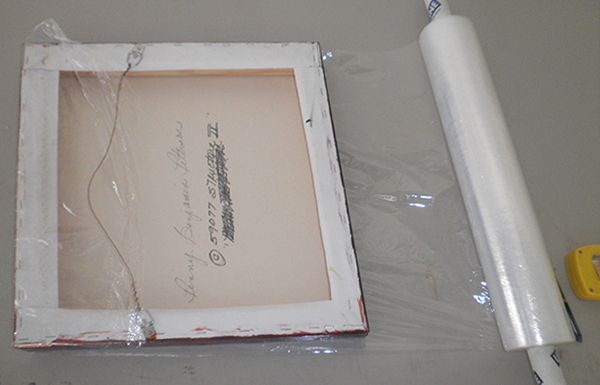 2. Cardboard padding
After the artwork is tightly wrapped in stretch film you must add thicker, more rigid protective layer of cardboard. This inner layer of cardboard will create a kind of second box, which will significantly protect your work. This box will also help to absorb shock if the package is dropped. You can take for example a piece of cardboard from a box that you do not need, but must be large enough to cover and go beyond painting (with about 5 cm.)
2. Cardboard padding
After the artwork is tightly wrapped in stretch film you must add thicker, more rigid protective layer of cardboard. This inner layer of cardboard will create a kind of second box, which will significantly protect your work. This box will also help to absorb shock if the package is dropped. You can take for example a piece of cardboard from a box that you do not need, but must be large enough to cover and go beyond painting (with about 5 cm.)
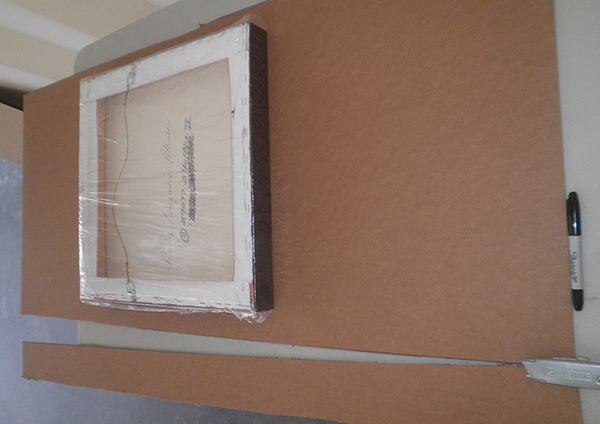 Instead of cutting and folding this extra space (5 cm.), simply squeeze the sides together to form a kind of triangle and tape it closed. By doing the ends this way, you create an additional buffer. Normally, the edges of the artwork or frame are the most prone to damage areas, and by creating this extra cushion, you create an almost impenetrable protection at both ends of the painting.
Once the cardboard pack is closed with tape you have to wrap well the package with bubble wrap like shown in the picture below:
Instead of cutting and folding this extra space (5 cm.), simply squeeze the sides together to form a kind of triangle and tape it closed. By doing the ends this way, you create an additional buffer. Normally, the edges of the artwork or frame are the most prone to damage areas, and by creating this extra cushion, you create an almost impenetrable protection at both ends of the painting.
Once the cardboard pack is closed with tape you have to wrap well the package with bubble wrap like shown in the picture below:
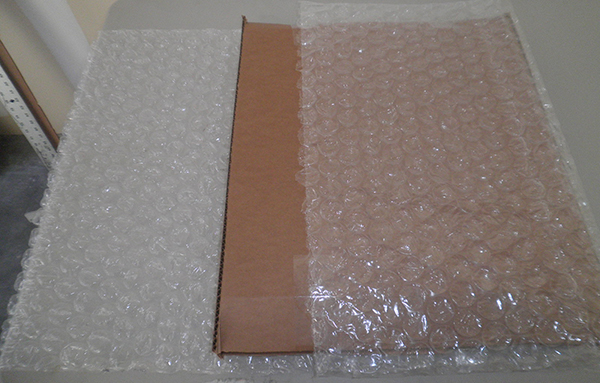
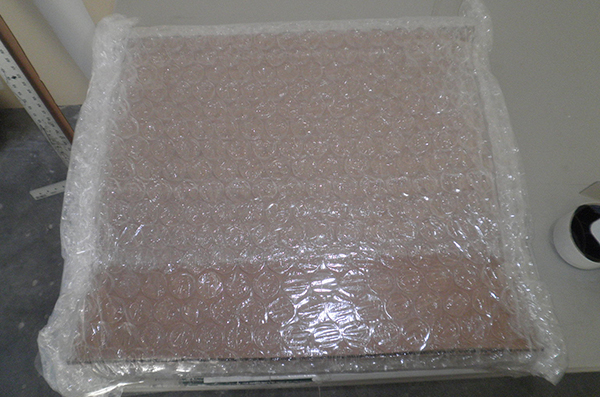 3. Bubble wrapping
The layer of bubble wrap provides extra cushioning and fills the space, preventing unwanted movement inside the box. When you have finished packing, make sure that the package is tightly wrapped.
4. The outer box
Finally, you must place the prepared package in an outer box, with the aim of keeping the outer box and the package inside as tight as possible.
The outer boxes are not that expensive and, when properly used provide adequate protection to keep your artwork during transportation. The most common cause for damaged frames is the movement within the extra empty space left inside the box during packing. If there is one, you should remove it by reducing the size of the box or you can fill the empty space with more bubble wrap (as long as that space is not very big). Finally, gently shake the box to make sure that the painting is stable and does not move.
The package should look like this before closing:
3. Bubble wrapping
The layer of bubble wrap provides extra cushioning and fills the space, preventing unwanted movement inside the box. When you have finished packing, make sure that the package is tightly wrapped.
4. The outer box
Finally, you must place the prepared package in an outer box, with the aim of keeping the outer box and the package inside as tight as possible.
The outer boxes are not that expensive and, when properly used provide adequate protection to keep your artwork during transportation. The most common cause for damaged frames is the movement within the extra empty space left inside the box during packing. If there is one, you should remove it by reducing the size of the box or you can fill the empty space with more bubble wrap (as long as that space is not very big). Finally, gently shake the box to make sure that the painting is stable and does not move.
The package should look like this before closing:
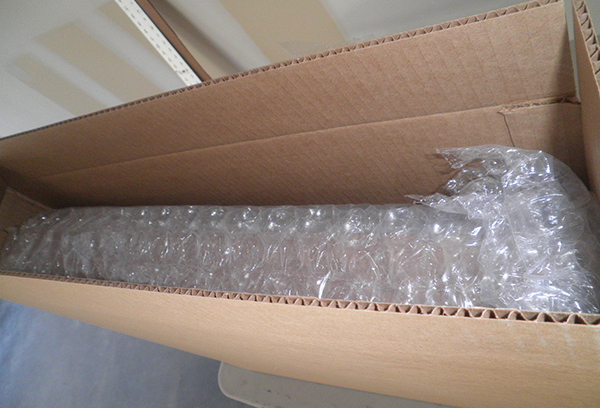 When closing the box, it is advisable to use a tape gun and good tape (sticky, not old). The device will allow you to apply proper tension while pulling the tape.
5. Dealing with glass
Sending watercolors behind a glass panel could be problematic. Glass is susceptible to cracking during transportation, and some carriers refuse to insure everything related to glass.
If you anyway decide to send glass, just be prepared that that will break and make sure that the glass pieces will not destroy the artwork. For example, you can put a special tape from 3M (like duck tape) on the entire surface of the glass (or at least in cross). If the glass breaks, the resulting shards will stick to the 3M tape instead of damaging the painting.
6. Stickers
The outer box should be marked with the sticker "Fragile" , so that people responsible for the handling and transportation to know that content is fragile and valuable. You can download several type of the stickers from the links below:
www . platform . net /shipping/ ............
If you are not able to print and put the sticker provided by us, ask the courier to give you one. If this is not possible, use a black or red marker, and write with capital letters FRAGILE on at least two sides of the box.
MISTAKES THAT YOU SHOULD AVOID WHEN PACKING
- Do not allow the bubble wrap to come into direct contact with your art.
- Do not use ugly boxes. Even if you use a brand new box, it will show signs of wear when arrives to the client. And if you decide to use an old box from the beginning, it will probably cause problems. As an artist, you want your client to feel that he is buying one of your masterpieces. With old or ugly box you will send the exact opposite message.
- Do not use Styrofoam peanuts (packaging chips, granules) when sending paintings.Bubble wrapping is the right material to fill in the empty spaces in the box. Never use Styrofoam peanuts or balls for this purpose. They are good for wrapping sculptures but have no place when sending paintings.
SHIPPING
We all should aim to send the artwork at reasonable cost, at the same time we must offer safety in transportation and professionalism in packaging.
INSURANCE
Despite your best efforts, works of art sometimes are damaged during transportation. Once the painting leaves your hands, the package will pass through a complex transport system with many moving parts. There is no way to completely eliminate the possibility of damage, so you need to plan that this will happen and we are obliged to make insurance when sending artworks.
The post office or some of the carrier companies limits its liability to a certain amount. It is a good practice to declare the value of the painting as announced in plARTform .
ADVICES IN CASE OF DAMAGE
In the rare event that damage occurs, the way we react, will affect the relationship with the customer and the likelihood of recovering the costs of any damage from the carrier’s insurance.
First of all, it is important to follow the packing procedures outlined above to send the paintings safely. You are in a far better position if the customer or transport company finds out that you have done everything in your power to protect the artwork.
Usually, when damage occurs during transportation, the customer will make a complaint and return the work to you. If there is no damage, but customer uses its right to return the painting, you become a recipient and you should carefully examine the box for mechanical damage on arrival. If there is damage, document it immediately. You can never have too many photos or too much documentation. Once you are sure that everything is fine, only then sign the delivery note to the carrier. If you have already signed, and then find the damage, the carrier’s company will not accept your claim and will not compensate.
When closing the box, it is advisable to use a tape gun and good tape (sticky, not old). The device will allow you to apply proper tension while pulling the tape.
5. Dealing with glass
Sending watercolors behind a glass panel could be problematic. Glass is susceptible to cracking during transportation, and some carriers refuse to insure everything related to glass.
If you anyway decide to send glass, just be prepared that that will break and make sure that the glass pieces will not destroy the artwork. For example, you can put a special tape from 3M (like duck tape) on the entire surface of the glass (or at least in cross). If the glass breaks, the resulting shards will stick to the 3M tape instead of damaging the painting.
6. Stickers
The outer box should be marked with the sticker "Fragile" , so that people responsible for the handling and transportation to know that content is fragile and valuable. You can download several type of the stickers from the links below:
www . platform . net /shipping/ ............
If you are not able to print and put the sticker provided by us, ask the courier to give you one. If this is not possible, use a black or red marker, and write with capital letters FRAGILE on at least two sides of the box.
MISTAKES THAT YOU SHOULD AVOID WHEN PACKING
- Do not allow the bubble wrap to come into direct contact with your art.
- Do not use ugly boxes. Even if you use a brand new box, it will show signs of wear when arrives to the client. And if you decide to use an old box from the beginning, it will probably cause problems. As an artist, you want your client to feel that he is buying one of your masterpieces. With old or ugly box you will send the exact opposite message.
- Do not use Styrofoam peanuts (packaging chips, granules) when sending paintings.Bubble wrapping is the right material to fill in the empty spaces in the box. Never use Styrofoam peanuts or balls for this purpose. They are good for wrapping sculptures but have no place when sending paintings.
SHIPPING
We all should aim to send the artwork at reasonable cost, at the same time we must offer safety in transportation and professionalism in packaging.
INSURANCE
Despite your best efforts, works of art sometimes are damaged during transportation. Once the painting leaves your hands, the package will pass through a complex transport system with many moving parts. There is no way to completely eliminate the possibility of damage, so you need to plan that this will happen and we are obliged to make insurance when sending artworks.
The post office or some of the carrier companies limits its liability to a certain amount. It is a good practice to declare the value of the painting as announced in plARTform .
ADVICES IN CASE OF DAMAGE
In the rare event that damage occurs, the way we react, will affect the relationship with the customer and the likelihood of recovering the costs of any damage from the carrier’s insurance.
First of all, it is important to follow the packing procedures outlined above to send the paintings safely. You are in a far better position if the customer or transport company finds out that you have done everything in your power to protect the artwork.
Usually, when damage occurs during transportation, the customer will make a complaint and return the work to you. If there is no damage, but customer uses its right to return the painting, you become a recipient and you should carefully examine the box for mechanical damage on arrival. If there is damage, document it immediately. You can never have too many photos or too much documentation. Once you are sure that everything is fine, only then sign the delivery note to the carrier. If you have already signed, and then find the damage, the carrier’s company will not accept your claim and will not compensate.
 2. Cardboard padding
After the artwork is tightly wrapped in stretch film you must add thicker, more rigid protective layer of cardboard. This inner layer of cardboard will create a kind of second box, which will significantly protect your work. This box will also help to absorb shock if the package is dropped. You can take for example a piece of cardboard from a box that you do not need, but must be large enough to cover and go beyond painting (with about 5 cm.)
2. Cardboard padding
After the artwork is tightly wrapped in stretch film you must add thicker, more rigid protective layer of cardboard. This inner layer of cardboard will create a kind of second box, which will significantly protect your work. This box will also help to absorb shock if the package is dropped. You can take for example a piece of cardboard from a box that you do not need, but must be large enough to cover and go beyond painting (with about 5 cm.)
 Instead of cutting and folding this extra space (5 cm.), simply squeeze the sides together to form a kind of triangle and tape it closed. By doing the ends this way, you create an additional buffer. Normally, the edges of the artwork or frame are the most prone to damage areas, and by creating this extra cushion, you create an almost impenetrable protection at both ends of the painting.
Once the cardboard pack is closed with tape you have to wrap well the package with bubble wrap like shown in the picture below:
Instead of cutting and folding this extra space (5 cm.), simply squeeze the sides together to form a kind of triangle and tape it closed. By doing the ends this way, you create an additional buffer. Normally, the edges of the artwork or frame are the most prone to damage areas, and by creating this extra cushion, you create an almost impenetrable protection at both ends of the painting.
Once the cardboard pack is closed with tape you have to wrap well the package with bubble wrap like shown in the picture below:

 3. Bubble wrapping
The layer of bubble wrap provides extra cushioning and fills the space, preventing unwanted movement inside the box. When you have finished packing, make sure that the package is tightly wrapped.
4. The outer box
Finally, you must place the prepared package in an outer box, with the aim of keeping the outer box and the package inside as tight as possible.
The outer boxes are not that expensive and, when properly used provide adequate protection to keep your artwork during transportation. The most common cause for damaged frames is the movement within the extra empty space left inside the box during packing. If there is one, you should remove it by reducing the size of the box or you can fill the empty space with more bubble wrap (as long as that space is not very big). Finally, gently shake the box to make sure that the painting is stable and does not move.
The package should look like this before closing:
3. Bubble wrapping
The layer of bubble wrap provides extra cushioning and fills the space, preventing unwanted movement inside the box. When you have finished packing, make sure that the package is tightly wrapped.
4. The outer box
Finally, you must place the prepared package in an outer box, with the aim of keeping the outer box and the package inside as tight as possible.
The outer boxes are not that expensive and, when properly used provide adequate protection to keep your artwork during transportation. The most common cause for damaged frames is the movement within the extra empty space left inside the box during packing. If there is one, you should remove it by reducing the size of the box or you can fill the empty space with more bubble wrap (as long as that space is not very big). Finally, gently shake the box to make sure that the painting is stable and does not move.
The package should look like this before closing:
 When closing the box, it is advisable to use a tape gun and good tape (sticky, not old). The device will allow you to apply proper tension while pulling the tape.
5. Dealing with glass
Sending watercolors behind a glass panel could be problematic. Glass is susceptible to cracking during transportation, and some carriers refuse to insure everything related to glass.
If you anyway decide to send glass, just be prepared that that will break and make sure that the glass pieces will not destroy the artwork. For example, you can put a special tape from 3M (like duck tape) on the entire surface of the glass (or at least in cross). If the glass breaks, the resulting shards will stick to the 3M tape instead of damaging the painting.
6. Stickers
The outer box should be marked with the sticker "Fragile" , so that people responsible for the handling and transportation to know that content is fragile and valuable. You can download several type of the stickers from the links below:
www . platform . net /shipping/ ............
If you are not able to print and put the sticker provided by us, ask the courier to give you one. If this is not possible, use a black or red marker, and write with capital letters FRAGILE on at least two sides of the box.
MISTAKES THAT YOU SHOULD AVOID WHEN PACKING
- Do not allow the bubble wrap to come into direct contact with your art.
- Do not use ugly boxes. Even if you use a brand new box, it will show signs of wear when arrives to the client. And if you decide to use an old box from the beginning, it will probably cause problems. As an artist, you want your client to feel that he is buying one of your masterpieces. With old or ugly box you will send the exact opposite message.
- Do not use Styrofoam peanuts (packaging chips, granules) when sending paintings.Bubble wrapping is the right material to fill in the empty spaces in the box. Never use Styrofoam peanuts or balls for this purpose. They are good for wrapping sculptures but have no place when sending paintings.
SHIPPING
We all should aim to send the artwork at reasonable cost, at the same time we must offer safety in transportation and professionalism in packaging.
INSURANCE
Despite your best efforts, works of art sometimes are damaged during transportation. Once the painting leaves your hands, the package will pass through a complex transport system with many moving parts. There is no way to completely eliminate the possibility of damage, so you need to plan that this will happen and we are obliged to make insurance when sending artworks.
The post office or some of the carrier companies limits its liability to a certain amount. It is a good practice to declare the value of the painting as announced in plARTform .
ADVICES IN CASE OF DAMAGE
In the rare event that damage occurs, the way we react, will affect the relationship with the customer and the likelihood of recovering the costs of any damage from the carrier’s insurance.
First of all, it is important to follow the packing procedures outlined above to send the paintings safely. You are in a far better position if the customer or transport company finds out that you have done everything in your power to protect the artwork.
Usually, when damage occurs during transportation, the customer will make a complaint and return the work to you. If there is no damage, but customer uses its right to return the painting, you become a recipient and you should carefully examine the box for mechanical damage on arrival. If there is damage, document it immediately. You can never have too many photos or too much documentation. Once you are sure that everything is fine, only then sign the delivery note to the carrier. If you have already signed, and then find the damage, the carrier’s company will not accept your claim and will not compensate.
When closing the box, it is advisable to use a tape gun and good tape (sticky, not old). The device will allow you to apply proper tension while pulling the tape.
5. Dealing with glass
Sending watercolors behind a glass panel could be problematic. Glass is susceptible to cracking during transportation, and some carriers refuse to insure everything related to glass.
If you anyway decide to send glass, just be prepared that that will break and make sure that the glass pieces will not destroy the artwork. For example, you can put a special tape from 3M (like duck tape) on the entire surface of the glass (or at least in cross). If the glass breaks, the resulting shards will stick to the 3M tape instead of damaging the painting.
6. Stickers
The outer box should be marked with the sticker "Fragile" , so that people responsible for the handling and transportation to know that content is fragile and valuable. You can download several type of the stickers from the links below:
www . platform . net /shipping/ ............
If you are not able to print and put the sticker provided by us, ask the courier to give you one. If this is not possible, use a black or red marker, and write with capital letters FRAGILE on at least two sides of the box.
MISTAKES THAT YOU SHOULD AVOID WHEN PACKING
- Do not allow the bubble wrap to come into direct contact with your art.
- Do not use ugly boxes. Even if you use a brand new box, it will show signs of wear when arrives to the client. And if you decide to use an old box from the beginning, it will probably cause problems. As an artist, you want your client to feel that he is buying one of your masterpieces. With old or ugly box you will send the exact opposite message.
- Do not use Styrofoam peanuts (packaging chips, granules) when sending paintings.Bubble wrapping is the right material to fill in the empty spaces in the box. Never use Styrofoam peanuts or balls for this purpose. They are good for wrapping sculptures but have no place when sending paintings.
SHIPPING
We all should aim to send the artwork at reasonable cost, at the same time we must offer safety in transportation and professionalism in packaging.
INSURANCE
Despite your best efforts, works of art sometimes are damaged during transportation. Once the painting leaves your hands, the package will pass through a complex transport system with many moving parts. There is no way to completely eliminate the possibility of damage, so you need to plan that this will happen and we are obliged to make insurance when sending artworks.
The post office or some of the carrier companies limits its liability to a certain amount. It is a good practice to declare the value of the painting as announced in plARTform .
ADVICES IN CASE OF DAMAGE
In the rare event that damage occurs, the way we react, will affect the relationship with the customer and the likelihood of recovering the costs of any damage from the carrier’s insurance.
First of all, it is important to follow the packing procedures outlined above to send the paintings safely. You are in a far better position if the customer or transport company finds out that you have done everything in your power to protect the artwork.
Usually, when damage occurs during transportation, the customer will make a complaint and return the work to you. If there is no damage, but customer uses its right to return the painting, you become a recipient and you should carefully examine the box for mechanical damage on arrival. If there is damage, document it immediately. You can never have too many photos or too much documentation. Once you are sure that everything is fine, only then sign the delivery note to the carrier. If you have already signed, and then find the damage, the carrier’s company will not accept your claim and will not compensate.

 French
French German
German Italian
Italian Spanish
Spanish Portuguese
Portuguese Russian
Russian Bulgarian
Bulgarian Polish
Polish Czech
Czech Greek
Greek Swedish
Swedish Hungarian
Hungarian Romanian
Romanian Croatian
Croatian Chinese
Chinese Albanian
Albanian Armenian
Armenian Belarusian
Belarusian Bosnian
Bosnian Estonian
Estonian Georgian
Georgian Latvian
Latvian Lithuanian
Lithuanian Macedonian
Macedonian Slovak
Slovak Serbian
Serbian Ukrainian
Ukrainian Dutch
Dutch Finnish
Finnish Danish
Danish Norwegian
Norwegian Irish
Irish Turkish
Turkish Korean
Korean Japanese
Japanese Arabic
Arabic Persian
Persian Hindi
Hindi